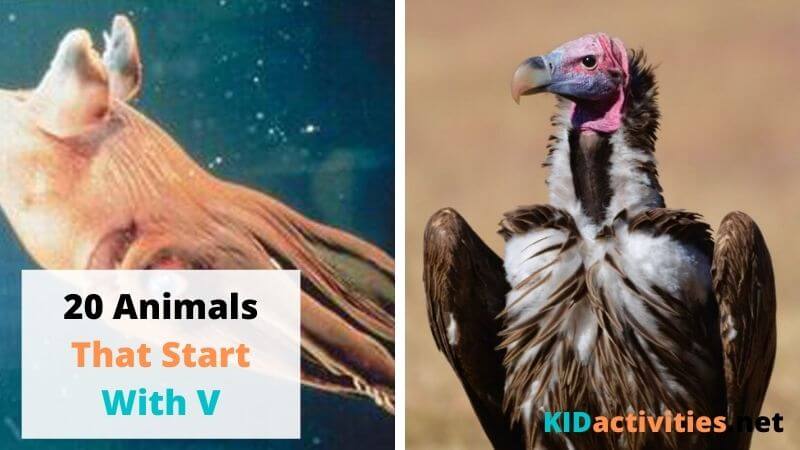In today’s article, we will discover 21 of the most amazing animals that start with the letter V.
Most of these animals are critically endangered. Scientists and conservationists are currently making desperate efforts to ensure their survival. Are you ready to discover them?
Animals that start with the letter V
1. Vulture
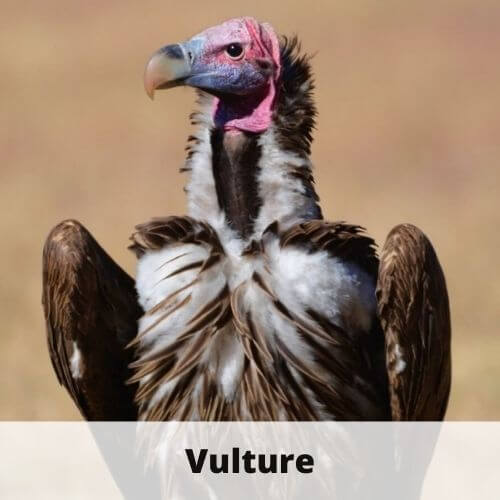
Except Australia and Antarctica, vultures can be found on all continents. Due to their high adaptability, this medium-large bird of prey can be found in a wide range of habitats, including plains, savannas, open mountain areas, and even suburban areas.
There are 23 species of vultures divided into two groups: the New World group (found in the Americas and the Caribe) and the Old World group (found in Europe, Africa, and Asia).
Unlike other prey birds, vultures are rather social. They can be seen flying, feeding, and roosting in large flocks.
Vultures are carnivorous and feed mainly on carrion. Even though they prefer fresh food, they will not hesitate to feed on rotten carcasses that other animals avoid eating due to their toxicity.
What keeps vultures safe from food poisoning are their extremely acidic stomach acids.
Thanks to these acids that have a very low pH (almost 0!), vultures not only don’t get sick but they also help to prevent the spread of diseases caused by rotting corpses.
Their stomach acids can dissolve botulism, cholera bacteria, and anthrax. Amazing garbage collectors, isn’t that so?
Vultures have excellent smell and sight, being able to spot dead animals from a distance. Despite the popular belief, vultures do not circle dying animals.
Even if, due to their abilities, they are able to spot corpses by smell and sight, it is practically impossible for them to know when an animal is dying.
Circling vultures do nothing but surveying an area in search of food. However, if food is scarce and they come across a wounded or sick prey, they won’t hesitate to attack it.
Since they feed on rotting corpses, vultures have relatively bare heads and necks.
There is a good reason for it: preventing bacteria and parasites from getting into their feathers while they eat, thus causing infections. Vultures usually live over 18 years; large species can live up to 50 years.
Interesting facts about Vultures
- Most species mate for life.
- Vultures have incredibly powerful bills that allow them to open carcasses. If they can’t open a carcass, they won’t mind waiting for other predators to open it. That’s why they can often be seen eating together with eagles, coyotes, or hyenas.
- Old World and New World species are not actually related. But they do share biological traits and functions. Actually, vultures are more related to storks than to other birds of prey.
- Their feet and legs are weak, making them unable to carry away their prey. To feed their young, vultures regurgitate food.
- A vulture can eat over 1 kg of meat per minute.
- New World vultures do not have a syrinx. This means they can only growl and hiss.
- Out of the 23 species that exist, more than half are listed as Threatened, Endangered, and even Critically Endangered. This happens mainly due to habitat loss and negative human impact.
- To keep their bodies cool, vultures urinate on their legs. This strategy also helps to kill bacteria and parasites that they may pick up when feeding on corpses.
- Since they soar, vultures can travel large distances with minimum energy expense.
- When in danger, vultures don’t hesitate to vomit. Their powerful stomach acids act as deterrents. But there’s more to it: by vomiting, they lighten up their bodies, thus being able to fly more easily and escape danger.
2. Viperfish
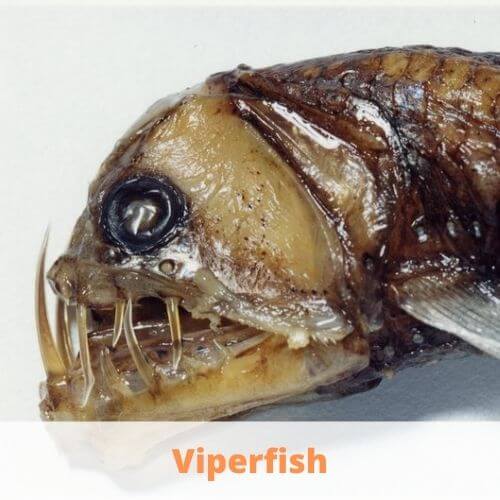
Inhabiting tropical and temperate waters, viperfish live at high depths of up to 2.800 m. Due to this fact, this elusive species is still a mystery in many aspects.
A deep sea fierce predator, the viperfish is famous for its sharp and large fangs that it uses to attack prey while swimming at an impressive speed.
Even though the viperfish has a large mouth, the fangs will curve back thus allowing the viperfish to close its mouth.
What makes this fish unique are the photophores located on its dorsal spine and body sides.
Photophores are organs that produce light. The viperfish flashes this light to lure its prey and impale it with its incredible jaws.
This process is called bioluminescence. Viperfish also seem to use light signals to communicate.
A relatively small fish, its colour varies from silvery blue to green, silver, or black. It feeds mainly on small fish and crustaceans.
Viperfish spend the day in deep waters. When the night comes, viperfish move up to shallower water in search of prey. This behaviour is called vertical migration.
Their biggest enemies are dolphins, dragonfish, and sharks.
It is believed to live up to 8 years in the wild. However, in captivity, viperfish only live a few hours, making it difficult for scientists to study them.
Interesting facts about Viperfish
- Behind its head, the viperfish has a vertebra that functions as a shock absorber. It is an extremely useful mechanism that allows it to rotate the head and swallow its whole prey.
- Viperfish have expandable, large stomachs that they use to store food.
- Despite their scary appearance, viperfish are only 30-60 cm long!
- According to recent research, viperfish can see in colour!
3. Verreaux’s Sifaka
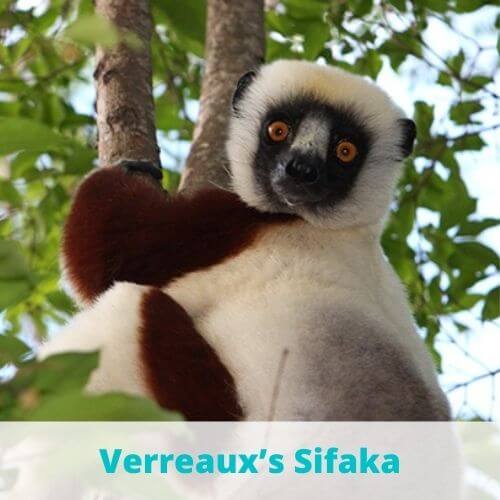
The Verreaux’s Sifaka is a primate endemic to Madagascar, currently listed as an endangered species due to habitat loss and human impact.
This lemur is easily recognized by its long and soft white fur, a dark brown head crown, and grey skin. Because of the gland located at the base of their throats, males present a reddish-brown chest patch.
Sifakas have long tails that help them improve balance when leaping from one tree to another.
Sifakas inhabit a wide range of habitats: tropical dry lowland forests, humid rainforests, or montane forests.
Verreaux’s sifakas are social animals living in groups of 2-13 members. The hierarchy system is dominated by females.
Generally, each group consists of 5-7 females, 2-3 males, and a couple of juveniles and infants.
Sifakas are herbivores, feeding mainly on flowers, bark, leaves, fruit, and nuts. They are active mainly in the morning and afternoon and they spend most of their time foraging for food.
Sifakas are very territorial and they use scent to mark their territory and make their presence known.
Their mating system is polygynous. That means that the dominant male mates with multiple females.
Sifakas live around 18 years and they thrive in captivity.
Interesting facts about Verreaux’s Sifaka
- Sifakas move in a particular way. When they are up in the trees, Sifakas take long leaps between the trunks. These leaps can reach 9-10m! However, on the ground, hopping is their only way of locomotion.
- A rather sedentary primate, Sifakas sleep from sunset to sunrise in the forest canopy.
- During the mating season, the alpha male often gets challenged by subordinate males. This leads to frequent fights.
- When food is abundant, Sifakas only look for quality. Instead of grabbing food with their hands, Sifakas prefer to use their mouths directly.
- Usually, during the breeding period, females accept a mate depending on the grooming it offered her. During the rest of the time, they groom each other.
4. Vicuña

The iconic animal of Peru (featured even on its coat of arms,) this mammal lives in the Andes and belongs to the camel family. They are closely related to alpacas, guanacos, and llamas.
The smallest camelid species, vicuñas have a tawny brown coat on the back and white hair on the chest and throat.
Vicuñas inhabit high elevations from 3,500 up to 5,750 meters. They prefer semiarid grasslands and plains, mainly covered with harsh dry vegetation.
However, they look for areas that provide them with easy access to water.
They spend the day foraging on grassy plains and the night high on the slopes.
Vicuñas are territorial and live in groups that consist of one male, 5-15 females, and their offspring.
Since they feed mainly on harsh grasses, vicuñas have rodent-like incisors.
In order to be able to live at high altitudes, their hearts are large and they are heavier than other mammals of a similar size. Vicuñas boast excellent sight and hearing.
Vicuñas are known to live 15-20 years in the wild. Their biggest enemies are pumas and foxes. However, condors won’t hesitate to attack young or weak vicuñas.
Interesting facts about Vicuña
- Vicuñas are highly appreciated for their wool, which is one of the finest fibres in the world. Since the quality of their wool is similar to angora wool and cashmere, vicuñas are subject to constant illegal poaching.
- Vicuñas are fast runners, being able to reach 50 km/h.
5. Vole
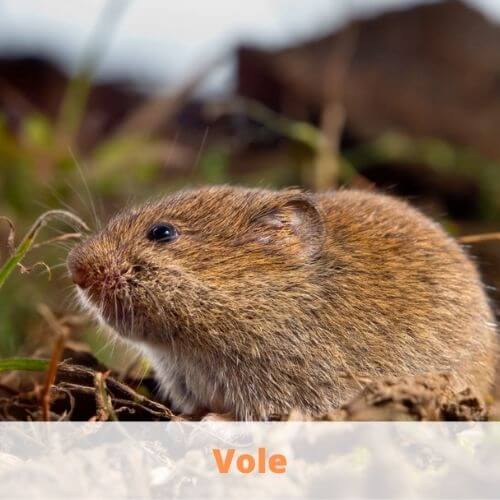
Closely related to mice, voles are small rodents that are widespread across Europe, North America, and Asia.
They can be found in a wide array of habitats, ranging from open grassland to prairies, lagoons, lakes, rivers, wetlands, scrub, forests, or mountain slopes.
There are approx. 155 vole species. If compared to mice, voles have smaller ears and eyes, a blunter and rounder muzzle, and shorter and hairier tails. Depending on the habitat, the fur can be white, brown, or grey.
Voles usually spend a lot of time in underground, complex burrows.
Voles are active all year round, with some species being nocturnal, others diurnal, or active day and night. Voles mainly feed on grasses, plants, bulbs, tubers, bark, and roots.
They use their underground burrows to store seeds and plants. Some species are omnivores, feeding also on snails and insects.
Their biggest enemies are snakes, martens, lynxes, owls, hawks, skunks, bobcats, falcons, coyotes, foxes, raccoons, and weasels.
Depending on the species, their lifespan ranges from 3-6 months to 1 year.
Interesting facts about Voles
- Similar to mice, voles are famous for their high reproduction rate. One litter may consist of up to 17 young.
- Some species (e.g. the European water vole) are excellent swimmers and divers.
- They communicate through scent marks and squeals.
- Some North American species, such as the red tree vole, are arboreal. They live in trees and are amazing climbers.
6. Volcano Rabbit
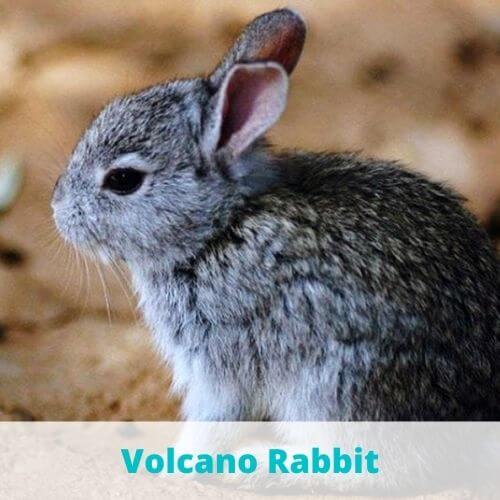
Closely related to pikas, volcano rabbits are endemic to Mexico and are listed as an endangered species due to habitat loss.
They inhabit grasslands and forests situated next to the four extinct volcanos close to Mexico City. Should any of these volcanos erupt, this species would become extinct.
The second-smallest rabbit species in the world (behind the pygmy rabbit), volcano rabbits usually live in small groups of 2-5 individuals. They have short ears and legs as well as short and dense fur.
Usually black or brown in colour, these tiny mammals blend perfectly with their volcanic habitat.
Their diet depends mainly on zacaton, a type of tall and dense grass that they also use to hide from predators and dig their burrows in. But they also feed on tree bark and plants.
A crepuscular mammal, the volcano rabbit is mainly active at dusk and in the early morning.
Their biggest enemies are hawks, weasels, and bobcats.
Their lifespan in the wild is of 12 years.
Interesting facts about Volcano Rabbits
- Their tails are so small that there are practically invisible to the eye.
- When in danger, volcano rabbits make high-pitched sounds to warn each other.
7. Vervet Monkey
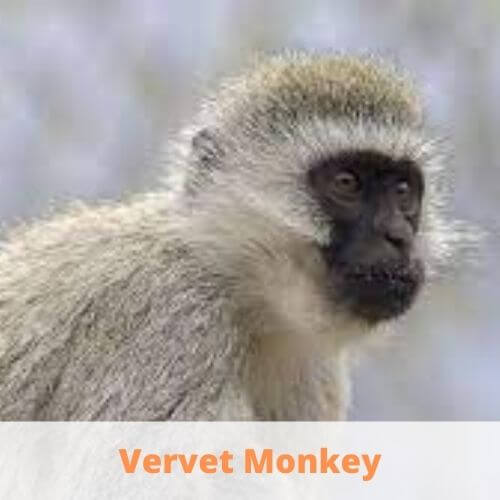
A medium-sized to large monkey species, Vervet monkeys are widely spread across sub-Saharan Africa. They belong to the Old World monkeys group, with five subspecies found in East Africa.
Vervet monkeys prefer savannas, forests, and scrublands often situated close to rivers and streams.
However, since food is abundant, they can often be found close to human settlements.
Even though they often get hunted for their meat and their population is under continuous threat due to habitat loss and human impact, vervet monkeys are still widespread.
Their fur is silvery-gray or dark green. Their faces, tail tip, feet, and hands are black. The face is framed with white hair. Males are heavier and larger than females. But what makes them stand out are the turquoise testicles.
Since they are excellent jumpers and climbers and spend almost all their life up in the trees, the long arms, legs, and tail help them achieve better balance and stability.
When walking, swimming, or foraging (even though it doesn’t happen very often), vervet monkeys use the four extremities.
Vervet monkeys are mainly active during the day. They are omnivores, feeding mainly on small birds, eggs, insects, lizards, crustaceans, grubs, leaves, roots, flowers, and buds.
Their biggest enemies are crocodiles, eagles, baboons, hyenas, pythons, leopards, and caracals.
Vervet monkeys are social animals, living in troops of 10 to 50 individuals. The troops consist of adult females and young offspring. Males only visit the troops to reproduce and socialize.
When in danger, Vervet monkeys use alarm calls – such as whistling and screaming – to alert each other. They have a specific alarm call for each type of predator.
Vervet monkeys usually live around 12 years in the wild. But, in captivity, they can live up to 24 years.
Interesting facts about Vervet Monkeys
- Every day, vervet monkeys dedicate a few hours to grooming each other, thus removing parasites and dirt from their fur. The dominant members get more grooming than the rest of the members.
- Young vervet monkeys love to wrestle. They often push each other off the branches to test their stability.
- Sadly, vervet monkeys are often used in medical and scientific researches.
- Vervet monkeys have a pouch in the mouth that allows them to store food and eat it later.
8. Vampire Bat
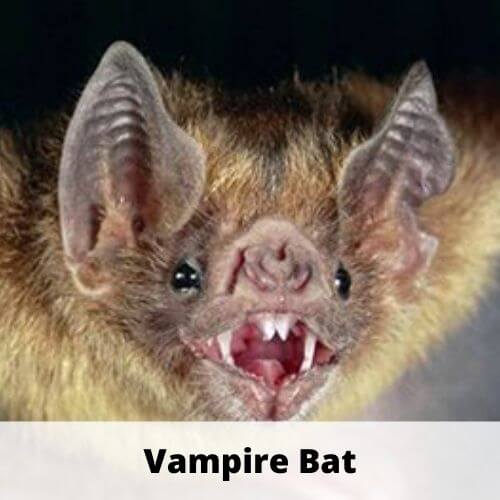
Found in tropical and sub-tropical areas in the Americas, this small mammal is exclusively blood thirsty!
In order to survive, vampire bats need to drink the blood of animals such as birds, cows, horses, pigs, and – rarely – even humans.
They use their sharp teeth to make small cuts and then use their tongues to drink the blood. Thanks to the chemicals in their saliva, the blood won’t clot.
The heat sensors located on their noses help them find the best feeding spots on their prey’s body.
They have large ears, a grey and brown coat, thumb claws on the wings, and powerful hind legs.
Since they have excellent eyesight, vampire bats are able to see their prey from impressive distances (around 130 m.) This species can walk, run, jump, and fly.
Vampire bats are nocturnal creatures and usually live in colonies that can range from 100 to over 1000 individuals, inhabiting dark places such as caves, buildings, mines, or hollow trees.
They choose totally dark places to sleep during the day, suspended upside down.
Their roosting social structure is the ‘harem’. Each harem consists of females, their offspring, several ‘resident’ males, and a separate ‘non-resident’ group of males.
Their biggest enemies are owls, hawks, and eagles. In the wild, they live around 9 years.
Interesting facts about Vampire Bats
- Due to their small size, the animal they attack often doesn’t even wake up.
- Vampire bats can locate their prey by recognizing the sound of their breathing.
- They can’t survive more than two nights without eating. However, they won’t hesitate to help each other. Those bats that have eaten will regurgitate blood to feed those in need.
- Vampire bats are known to spread rabies.
- Vampire bats are quite friendly to humans.
- During their first 3 months of life, young vampire bats feed exclusively on their mother’s milk.
- Pregnancy lasts 7 months!
- Even though they live in colonies, they hunt on their own.
- They are the only flying mammals!
9. Vampire Squid
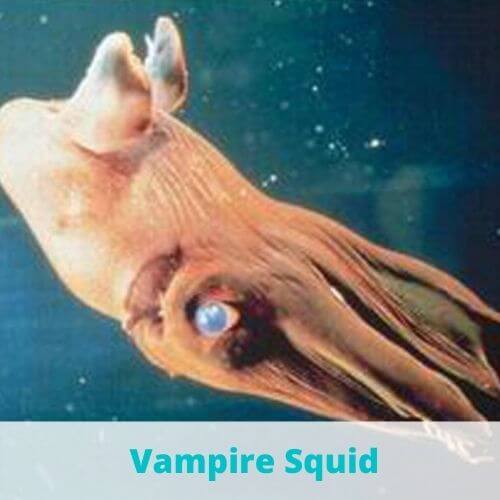
A small cephalopod that inhabits the depths of temperate and tropical oceans, the vampire squid appeared 300 million years ago.
The part of the ocean Vampire squids live in is called the oxygen minimum zone. There aren’t many species that can survive in that area.
But vampire squids have an ace up their sleeves: large gills that allow them to intake as much oxygen as possible and a low metabolic rate.
Black or reddish in colour, vampire squids have 8 webbed arms equipped with spines and suckers.
They earned their name due to their large, red eyes, white, beak-like jaws, and cape-like webbed skin. Resembling squids and octopuses alike, vampire squids have a soft and gelatinous body.
Vampire squids feed mainly on small invertebrates, plankton, and copepods.
Young vampire squids use jet propulsion to move. Inside their mantle, there is a siphon that they use to eject water. On the sides of the mantle, adults have fins that they flap to move.
Their bodies are almost completely covered with photophores (i.e. organs that produce light) that they use to defend against predators and lure prey. Their biggest enemies are whales, sea lions, and other large fish.
Interesting facts about Vampire Squids
- They only eat a couple of times per week.
- Vampire squids move at impressive speeds, reaching twice their body length per second.
- When in danger, vampire squids use a very interesting strategy: they expose their spines by inverting their skin. This way they protect their vulnerable body parts (such as the neck or the head). What’s more, they release glowing mucus to confuse predators.
- It is believed that, during incubation, females don’t eat. As soon as the eggs hatch, they die of exhaustion.
10. Vaquita
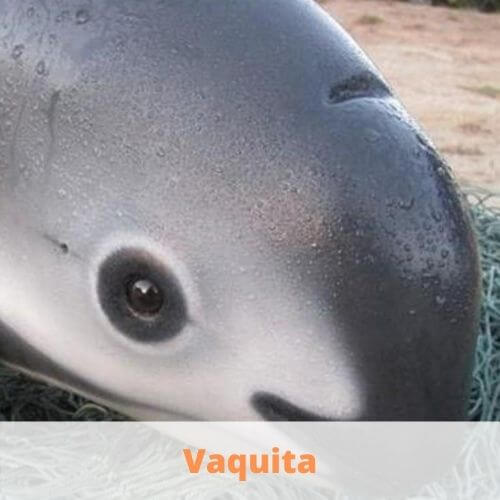
A vanishing porpoise species with less than 30 specimens left, vaquitas are the smallest cetacean.
They weigh roughly 55 kg. Their habitat measures 2,330 km² and it is located in the Gulf of California, Mexico.
Vaquitas prefer shallow lagoons (less than 50 m deep) not far away from the shore.
The eyes of the vaquita are surrounded by black rings. They have round heads, curved, black lips, a dark grey back, pale grey sides, and white undersides.
Females are slightly longer than males. Since they live in warm waters and need to control their body temperature, vaquitas have large dorsal fins. They navigate and communicating using echolocation.
Vaquitas feed mainly on squids, crustaceans, and small fish. A rather elusive mammal, vaquitas are often seen alone or in groups of 2-3 individuals.
Vaquitas are believed to live around 20 years.
Interesting facts about Vaquitas
- Females give birth every 2 years after a gestation that lasts 10-11 months.
- In Spanish, vaquita means ‘little cow’.
- Most vaquitas have been accidentally killed in fishing nets. Since it is a critically endangered species, scientists have developed special nets that vaquitas could avoid and would still allow fishermen to catch shrimp and fish.
- Scientists have managed to preserve vaquita cells that might be used to sequence the vaquita genome.
11. Vancouver Island Marmot

Belonging to the squirrel family, the Vancouver Island Marmot is one of the rarest mammals and it is currently enlisted as endangered species.
It can be found exclusively on Vancouver Island, inhabiting high mountainous areas.
Vancouver Island marmots have strong bodies, chubby faces, and small ears. Their fur is brown and they have a creamy patch around their mouth and nose.
Thanks to their long claws, Vancouver marmots are excellent climbers. The claws help them dig burrows and move easily across the rocky regions.
The Vancouver marmot lives in groups of 7-8 individuals. They are vegetarians and feed on plants, herbs, and grass. Their biggest enemies are cougars, wolves, and eagles.
Interesting facts about Vancouver Island Marmot
- When in danger, they make a whistle-like sound. Due to this fact, they are also commonly called ‘whistle pigs’.
- 800- to 2,600 years old Vancouver Island marmot bones have been discovered in caves. The marks on these bones suggest that this species was hunted with stones and shell tools for its meat and fur.
- They spend seven months underground. During hibernation, they lose 30%-50% of their body mass.
- The age of this marmot can be deduced from the fur colour. While pups are dark brown, their fur fades to rust and then dark brown as they grow.
12. Vanga
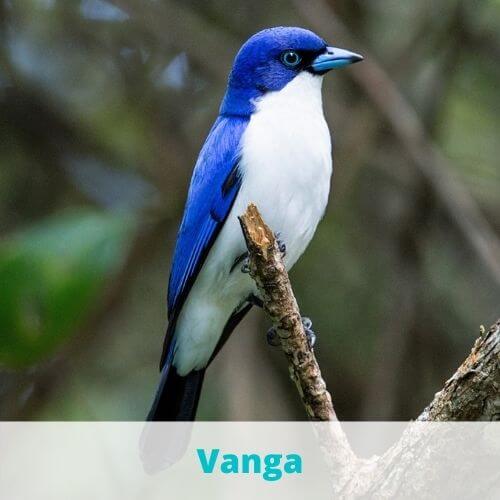
Small to medium-sized, Vangas are perching birds that can be found exclusively in Madagascar.
The Blue Vanga is the only exception: it can be found on the Mohéli island. Vangas are non-migratory birds. There are 15 vanga species.
They inhabit rainforests, deciduous forests, spiny subdeserts, and other wooded areas close to primary forests.
The plumage of most species is blue or black above and white below. They have stout, hook-tipped bills, short wings, and medium-length tails.
Most Vanga species feed on amphibians, lizards, insects, millipedes, and earthworms.
The Blue Vanga and the Chabert’s Vanga also eat fruits. Generally, Vangas forage in flocks, together with other birds such as drongos or jerys. Most vanga species live in pairs or small groups.
Interesting facts about Vanga
- Since their habitat is limited, Vangas are slow flyers.
- Vangas are vocal birds and have diverse calls.
13. Variegated Squirrel

Native to Central America, variegated squirrels are tree squirrels. They are medium-sized, have long ears, and bushy tails.
Usually, they inhabit dry deciduous forests, mixed forests, woodlands, scrublands, and plantations.
Variegated squirrels are solitary animals and mainly active during the day. Variegated squirrels spend most of the time up in the trees.
They have been seen spending their nights in nests that they build on the ground.
But they usually build their nests in tree holes or between tree branches. They are very agile and can easily leap from one branch to another.
They feed mainly on seeds, fruits, insects, and nestlings. Their biggest enemies are snakes, owls, eagles, foxes, wildcats, and weasels.
In the wild, they live 8-12 years.
Interesting facts about Variegated Squirrel
- Variegated squirrels don’t hibernate.
- When in danger, variegated squirrels chatter and make chucking sounds.
14. Velvet Asity
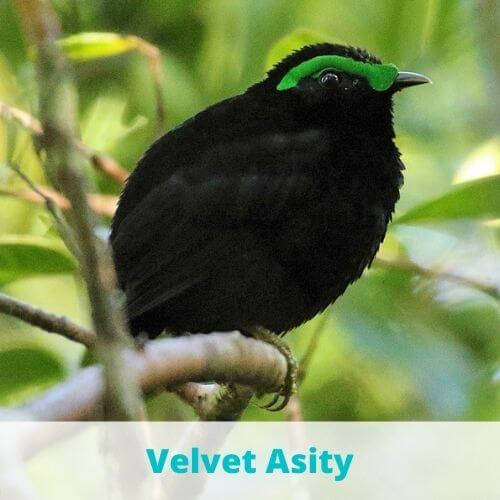
Endemic to Madagascar, they inhabit tropical and subtropical moist lowland forests.
After moulting, the male’s feathers have yellow tips. But they soon wear off and leave the male all black. Males also have bright green wattles. Females are greenish.
Their diet consists mainly of berries and other fruit.
Interesting facts about Velvet Asity
- Their elaborated, hanging nests have small roofs over the entrance. The nest is built by both the female and the male. However, only the females incubate the eggs.
- Since they are restricted to Madagascar and there aren’t many frugivorous bird species on the island, they play a crucial role as seed dispersers.
15. Viper
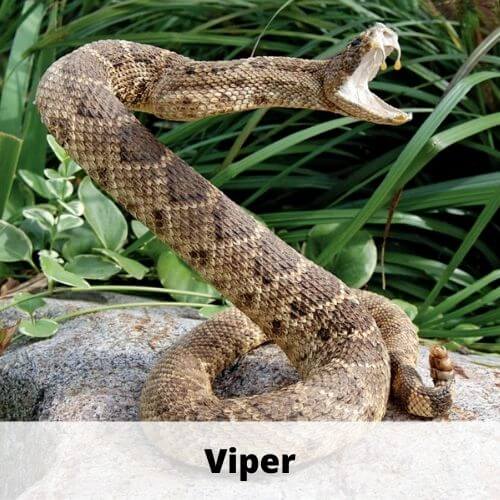
The Viper family consists of over 200 species of venomous snakes. Viper snakes can be found all over the world, except Ireland, Madagascar, Hawaii, Antarctica, Australia, north of the Arctic Circle, and New Zealand.
They inhabit mountains, deserts, rainforests, and fields.
Vipers have long, hollow, hinged fangs that allow them to perforate the venom into their prey.
A rotating maxillary bone is connected to the fangs that can move separately or in conjunction. When not needed, then fangs tuck back to the roof of the mouth.
They have vertical, oval-shaped pupils that allow them to see at various light levels.
Viper snakes have keeled scales, a thick build, and short tails. The glands that produce the venom are located on the back of the upper jaw. As a consequence, viper snakes have triangular-shaped heads.
Generally, viper snakes feed on rodents, frogs, lizards, small birds, and other small animals that can be found in their habitat.
When the prey is dead, vipers swallow it whole. They are mainly active at night.
Some species lay eggs, while some others give birth to live young.
Interesting facts about Vipers
- When striking their prey, Viper snakes open their mouths to almost 180 degrees.
- When they are defending themselves, Viper snakes usually use non-venomous bites.
- The most venomous vipers can be found in tropical areas, especially in Africa and South America. The venom of the viper snakes that live in colder climates is less venomous.
- Their hunting tactic is called prey relocation. Once the venom is injected, viper snakes release their prey, thus avoiding being bitten back. If the bitten prey walks away and dies, the viper will use its smell to locate it.
- Mao-Lan pit viper is the smallest viper snake. They are less than 61 cm long. The South American Bushmaster is the longest viper and can grow over 335 cm.
- 57 viper snake species are listed as near threatened, endangered, vulnerable, conservation-dependent, critically endangered, or extinct in the wild. The golden lancehead and the Santa Catalina rattlesnake are some of the rarest vipers in the world.
16. Vireo
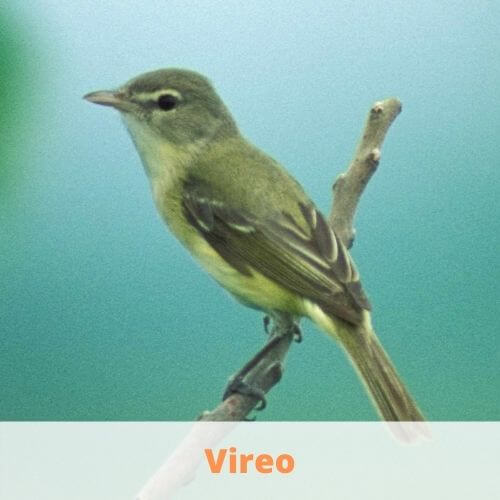
Found exclusively in the New World, there are approx. 50 vireo species. They can be found in North, South, and Central America.
Generally shy, vireos are 10-18 cm long. Their plumage is green or grey with yellow or white touches.
Other plumage colorations include yellow, blue, brown, etc. Generally, they have long legs and short, narrow bills.
They can be found in various types of habitats, including forests, woodlands, swamps, wetlands, mangroves, shrubs, etc. They usually live on tree tops.
Vireos mainly feed on insects and invertebrates such as flies, ants, mosquitoes, beetles, spiders, caterpillars, or butterflies.
But, occasionally, they also feed on berries and fruits. They are diurnal birds and live in pairs or small flocks.
Interesting facts about Vireo
- Since they don’t thrive in captivity, vireos don’t make good pets.
- Males use singing to defend their territories against other males.
17. Virginia Opossum
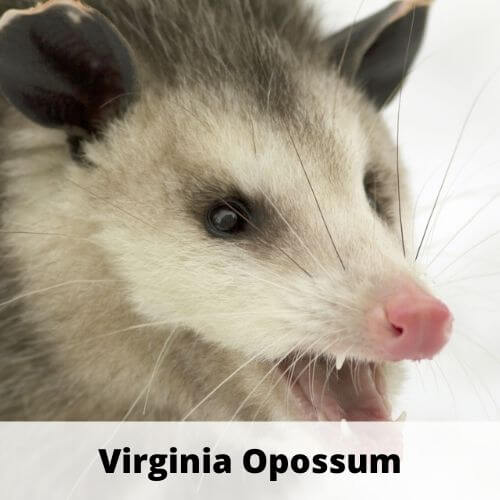
The only living North-American marsupial, the Virginia opossum can be widely found in the eastern U.S.
Virginia opossums are approx. 76 cm long and their fur is usually grey or black.
They have hairless, grasping tails, triangular heads and long pointed noses. On their abdomens, females have a pouch, lined with fur, in which they keep the under-developed young.
Virginia opossums are mainly active at night. During the day, they sleep in dens that they build in hollow trees. They prefer forested habitats that are close to water.
But they are also frequently seen near human settlements. Even if they are skilled climbers, they spend most of their time on the ground.
Virginia Opossums are omnivores, feeding mainly on insects, mice, lizards, snails, fruit, berries, seeds, nuts, grass, and even carrion.
Interesting facts about Virginia Opossum
- They don’t hesitate to use other rodents’ abandoned burrows.
- They use smell and touch to find food.
- When attacked, opossums try to fool the attacker by playing dead: they stay still, without blinking, and stick their tongues out. It can ‘play possum’ for several hours. And, many times, they are successful.
- They use their grasping tails to carry grass and leaves that they will use to build their nests.
- When born, Virginia opossums have the size of a bee!
- Opossums don’t hibernate. However, during cold weather, they can sleep for several days in a row.
- Often, litters outnumber the available teats. The young that don’t find a teat die.
- Opossums have 50 sharp teeth. No other land mammal has so many teeth.
18. Visayan Spotted Deer
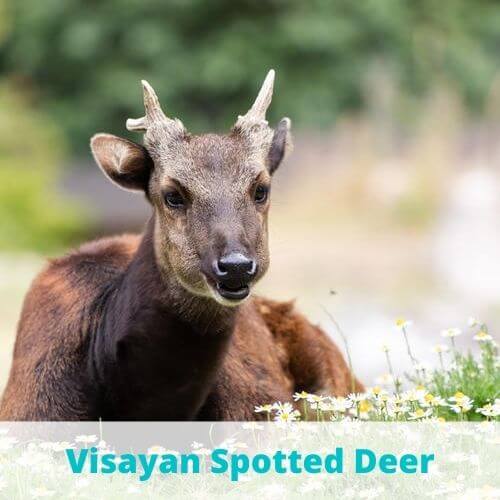
As their name suggests, the Visayan Spotted Deer can be found on the Visayan Island. It is a small-sized deer species (more or less the size of a dog).
They inhabit forested areas and they mainly feed on grass and leaves. Nowadays, this species is enlisted as critical with only around 2.500 of them left.
They are mainly active at night.
They are deep brown and have beige spots distributed in an A pattern. They maintain these spots all their lives (unlike most deer species).
Their underparts are cream and have white fur on the lower lip and chin.
19. Visayan Warty Pig
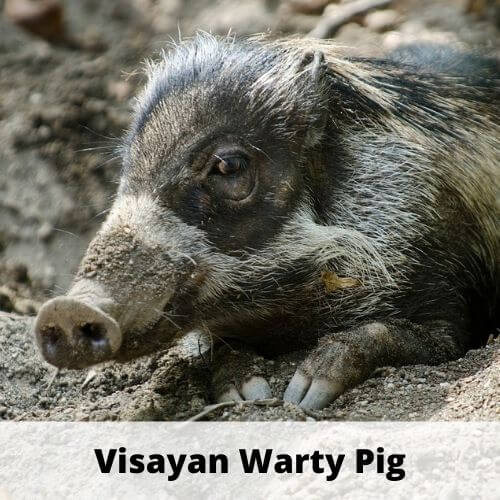
As its name suggests, the Visayan warty pig is endemic to the Visayan Island. It is a small-sized that pig that inhabits grasslands and primary and secondary forests. Once again, we are talking about critically endangered species.
Males are much larger than females. During the breeding season, males grow crests and manes up to 23 cm long.
They are dark grey and their bodies are covered with sparse, bristly hairs. Between the ears, they have a tuft of hair.
They owe their name to the 3 pairs of “warts” that males have on their faces. These warts protect their faces during fights.
They live in groups of 3-6 members. Each group consists of a male, several females, and their young.
They forage in family groups and use grunts and squeaks to communicate. Visayan Warty Pigs are not territorial. They are active at night and spend the day sleeping in hollows.
They are omnivores feeding mainly on fruits, roots, tubers, earthworms, and also cultivated vegetable and cereal crops.
Interesting facts about Visayan Warty Pig
- Males sometimes live in bachelor groups.
20. Viscacha
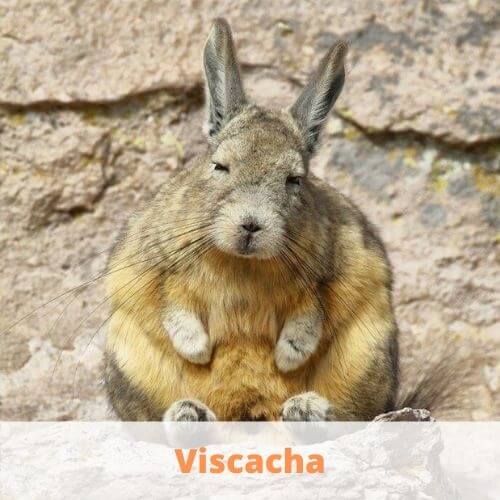
Viscachas are large rodents closely related to chinchillas. The three existing species of mountain viscachas can be found in Peru, Bolivia, Chile, and Argentina.
They inhabit rocky areas at high altitudes (4,000 to 5,000 m) where vegetation is not abundant.
Despite the fact that they are extensively hunted for their meat and fur, they are not listed as endangered species.
Their fur is dense and soft, grey or brown on the back and grey, white, or yellow underside.
However, the fur’s colour varies with age and season. They have long, fluffy tails. Since they live in the mountains and need to move across rocky terrains, their feet have fleshy pads.
Their front feet are short, while their hind feet are long and strong, making them excellent jumpers.
Viscachas are very vocal. They communicate via a wide variety of sounds. They usually live in large colonies of more than 80 members. Each colony consists of various family groups.
Viscachas are mainly active during the day and spend most of their time eating, grooming, and bathing in the sun.
They feed on lichens, grass, and mosses. Their biggest enemies are the birds of prey and wildcats. In captivity, viscachas can live around 19 years. Their lifespan in the wild is unknown.
Interesting facts about Viscacha
- When viscachas rest, their tail is curved. When they move, their tails are fully extended.
- Since viscachas are not good diggers, they build their burrows in rock crevices.
- Viscachas live at high altitudes, where water is scarce. As a consequence, they rarely drink water. They hydrate themselves with the moisture from food.
- When in danger, viscachas use bird-like whistles as an alarm call.
21. Vinegaroon
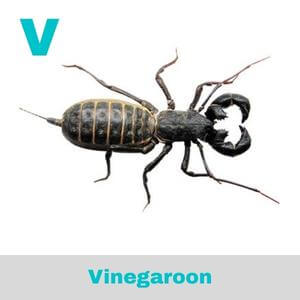
More like a spider than a scorpion, when this scorpion feels intimidated, it sprays acid that has the smell of vinegar for protection.
The Vinegaroon scorpion is also known as the Whip scorpion.
They are not very harmful to humans as their acid stings but not fatal compared to other scorpions and spiders.
Interesting facts about Vinegaroon
- Despite the terrifying look, these scorpions are actually very receptive to humans, so many keep them as pets.
- You can actually eat the Vinegaroon spider, if you can stomach the look.
More animal posts:
